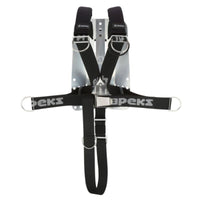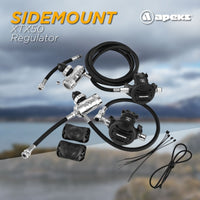Plongée
Dive Tek Gears
Dive Tek, or technical diving, involves going beyond recreational scuba diving limits and requires specialized gear to handle the increased risks and challenges. Here's a look at some of the critical pieces of Dive Tek gear:
Twin Tanks
Twin tanks, or double cylinders, are standard in technical diving. They provide a larger gas supply, crucial for longer dives and decompression stops. They're typically made of steel or aluminum and are connected by a manifold for balanced use of gas.
Sidemount System
A sidemount system allows divers to carry one or two cylinders on their sides instead of on their backs. This configuration provides better buoyancy control, reduces strain on the back, and offers an easy way to enter and exit the water.
Technical BCD
Technical BCDs are designed to handle the heavy gear load of technical diving. They often feature a wing-style design for better horizontal trim, a backplate for added stability, and multiple D-rings for equipment attachment.
Decompression Cylinders
Decompression cylinders, or stage bottles, carry additional gas mixes for different depths. It is essential for staged decompression, allowing divers to ascend safely from deep dives.
Dive Computers
Technical dive computers are designed to handle multiple gas mixes and calculate decompression schedules. Some models can also monitor tank pressure and provide digital compasses.
Dry Suit
Dry suits are often used in technical diving to handle cold water temperatures. They're sealed to keep water out and allow divers to wear insulating layers underneath.
Rebreathers
Rebreathers recycle exhaled gas by removing carbon dioxide and adding oxygen, allowing divers to stay underwater for extended periods. They also provide optimal gas mixtures at different depths.
Cave and Wreck Diving Equipment
Technical diving often involves cave or wreck exploration, which requires additional gear like reels for laying guidelines, powerful torches for illumination, and knives or cutting tools for emergencies.
In conclusion, Dive Tek gear is designed to handle the demands of technical diving. It provides the necessary safety, durability, and functionality for dives that go beyond the scope of recreational diving. Always remember that technical diving requires advanced training and experience, so ensure you're appropriately certified before attempting any technical dives.
Dive Tek
Dive Tek, or technical diving, is a form of scuba diving that surpasses the limits imposed on depth and immersion time set by recreational diving. Technical diving often involves the use of specialized equipment and training. Here's what you need to know:
What is Dive Tek?
Dive Tek, or technical diving, is a term used to describe all diving practices that go beyond the limits established for recreational scuba diving. It includes deep diving, cave diving, wreck diving, ice diving, and diving with different gas mixtures.
Who Can Participate?
Technical diving is only for some. It requires more equipment, training, and experience than recreational diving. Divers interested in technical diving usually need to have a high level of fitness, a deep understanding of diving physics and physiology, and a significant amount of diving experience.
Training and Certification
Technical diving requires specialized training beyond what is covered in an introductory scuba certification course. This training often includes advanced buoyancy control, navigation, emergency procedures, and using different gas mixtures. Several organizations, including PADI, offer technical diving courses and certifications.
Equipment Used in Dive Tek
Technical diving often requires additional equipment compared to recreational diving. It can include multiple gas tanks, dive computers, decompression trapezes, and specialized suits. The exact equipment needed depends on the type of technical dive being performed.
Risks and Safety
Technical diving is more risky than recreational diving due to the environments in which it is performed and the depths reached. However, these risks can be managed with proper training, planning, and equipment. Safety is a top priority in technical diving, and divers are trained to handle a variety of emergencies.
Benefits of Dive Tek
Despite its challenges, technical diving can be incredibly rewarding. It allows divers to explore places few people ever see, such as deep underwater caves and historic shipwrecks. It also offers a sense of adventure and accomplishment beyond what is experienced in recreational diving.
In conclusion, Dive Tek, or technical diving, is a challenging and exciting form of scuba diving that allows divers to push the boundaries of underwater exploration. It requires significant training and equipment, but for those who are up for the challenge, it can offer an unparalleled diving experience.





